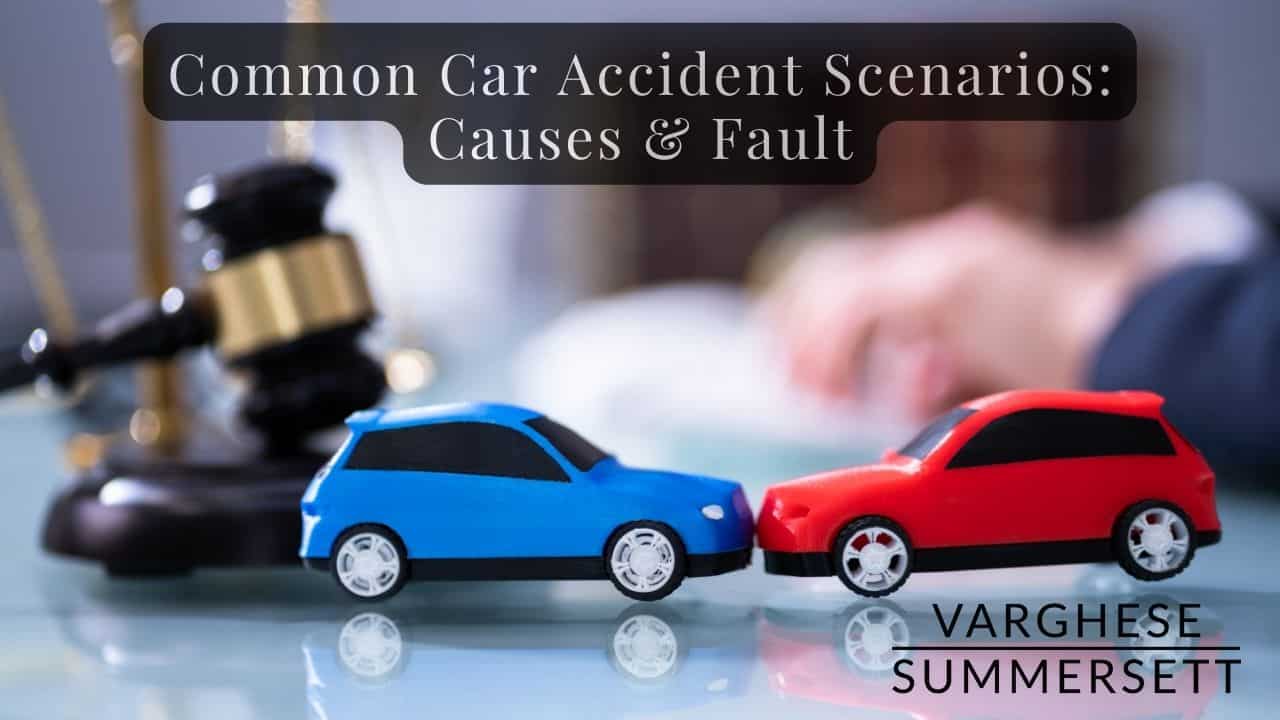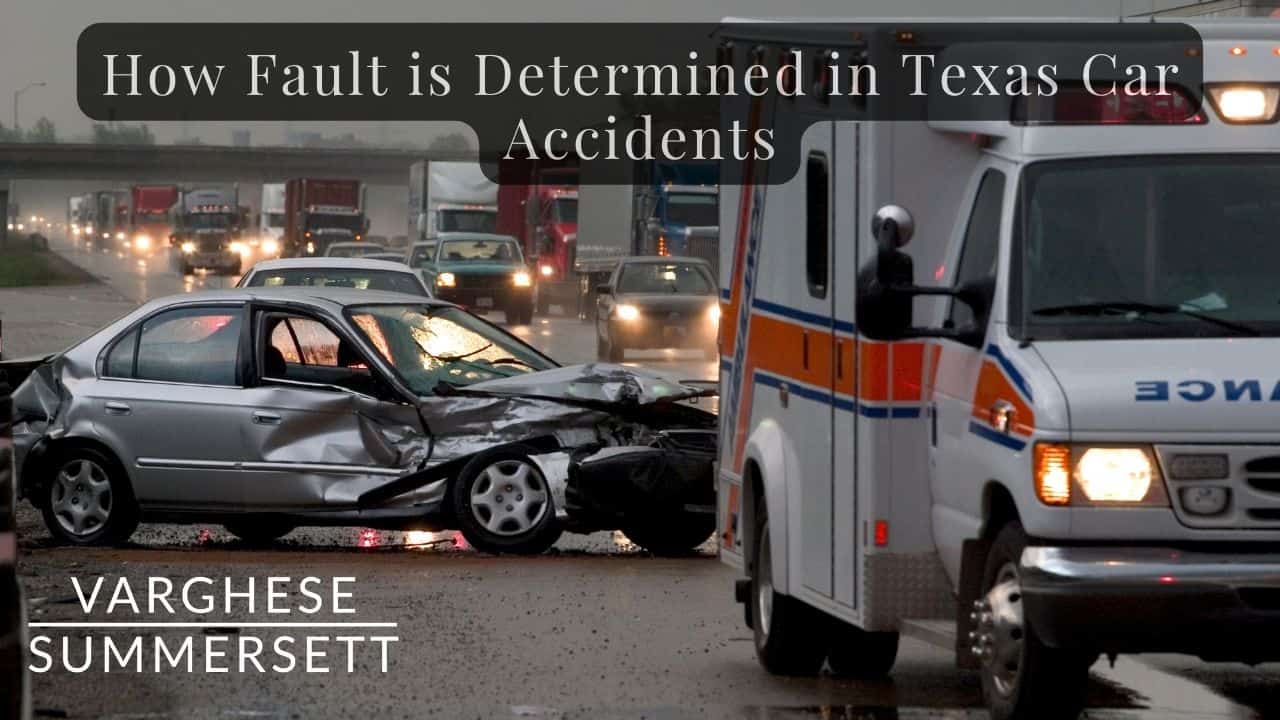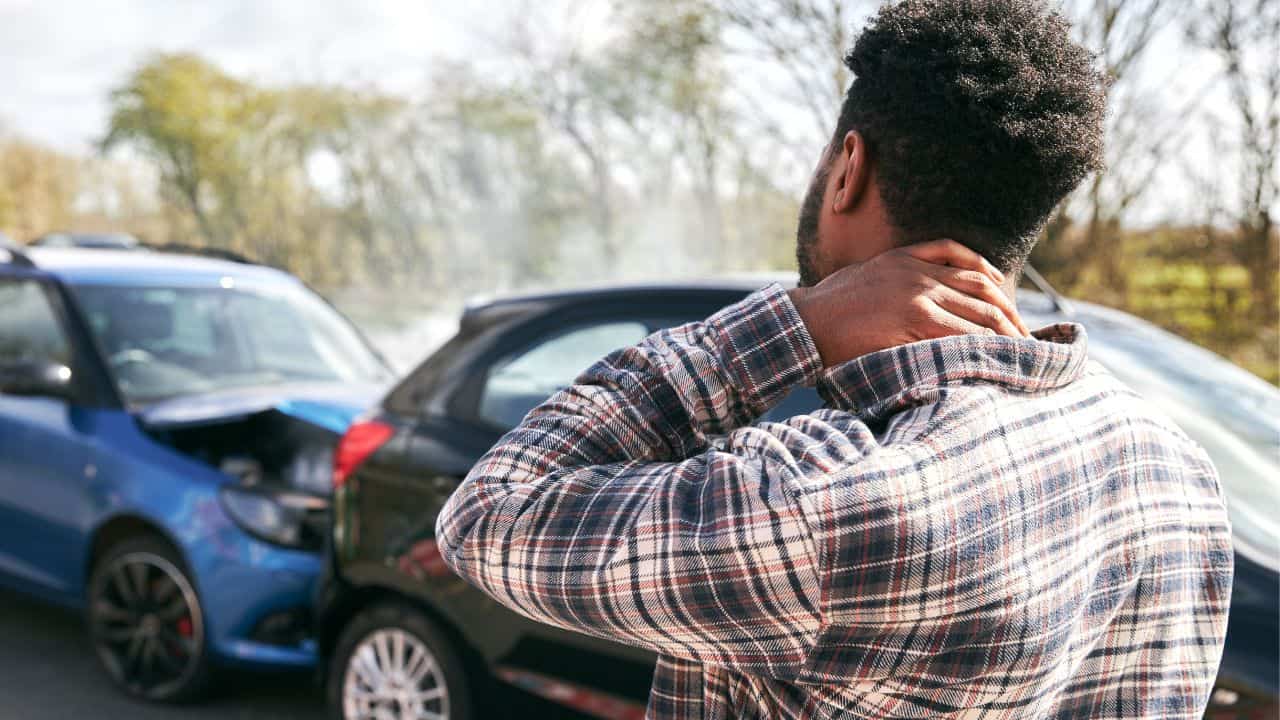
Common Car Accident Scenarios: Who is at Fault?
Common Car Accident Scenarios in Texas
Car accidents are an unfortunate reality of modern life. Understanding common car accident scenarios can help drivers be more vigilant on the roads, potentially avoiding accidents altogether. In this article, we will discuss the most common types of car accidents and their contributing factors, as well as provide valuable insights into prevention and legal implications.
This post will examine Texas’s most common car accident scenarios, how fault is determined, and how our personal injury attorneys can help you receive the compensation you deserve.
What are the Most Common Types of Car Accidents?
Rear-End Collisions: One of the most common car accident scenarios are rear-end collisions, which occur when one vehicle strikes the back of another. These accidents are often the result of tailgating or distracted driving. In most cases, the driver of the vehicle that rear-ends another car is considered at fault.
T-Bone Accidents: T-bone accidents, also known as side-impact collisions, occur when the front of one vehicle collides with the side of another. These accidents often happen at intersections when a driver fails to yield or runs a red light.
Head-On Collisions: Head-on collisions are among the most dangerous types of car accidents, as they typically involve high speeds and severe impacts. These accidents can result from a driver veering into oncoming traffic or driving the wrong way on a roadway.
Common Car Accident Scenarios
Rear-End Collisions
Rear-end collisions are one of the most frequent car accident scenarios. These accidents often occur when the following vehicle fails to maintain a safe distance or reacts too slowly to a sudden stop.
Causes
- Distracted driving
- Tailgating
- Sudden stops
- Poor weather conditions
- Mechanical failure
Prevention
- Maintain a safe following distance
- Stay focused on the road
- Regular vehicle maintenance
Legal Implications
The driver of the following vehicle is typically found at fault.
The primary reason for this is the general expectation that drivers should maintain a safe following distance, allowing ample time and space to react to sudden stops or changes in traffic conditions.
- Safe Following Distance: The key to avoiding rear-end accidents is to maintain a safe following distance from the vehicle in front. This distance allows drivers enough time to react and brake in case the leading vehicle comes to an abrupt stop. By maintaining a safe distance, the rear driver can prevent collisions caused by sudden stops, congestion, or unexpected obstacles on the road.
- Reaction Time: Human reaction time plays a significant role in rear-end accidents. Even if the rear driver is paying attention, it takes time to process the need to brake and take action. A safe following distance gives the rear driver extra time to react, which is essential for preventing accidents.
- Legal Presumptions: In many jurisdictions, there is a legal presumption that the rear driver is at fault in a rear-end collision. This presumption is based on the idea that, had the rear driver maintained a safe following distance and paid attention to the road, they would have been able to stop or avoid the collision. To overcome this presumption, the rear driver must provide evidence to show that the leading driver’s actions contributed to the accident or that there were other extenuating circumstances.
- Exceptions: While the rear driver is often held responsible for rear-end accidents, there are exceptions. In some cases, the leading driver may be found partially or entirely at fault. For example, if the leading driver suddenly reverses, brakes without reason, or has non-functioning brake lights, they may be held accountable for the accident.
T-Bone Accidents
T-bone accidents are also also known as side-impact or broadside collisions, occur when one vehicle crashes into the side of another, forming a “T” shape. These accidents are particularly dangerous due to the limited protection offered by a vehicle’s side panels.
Causes
- Failure to yield
- Running red lights or stop signs
- Distracted driving
Prevention
- Obey traffic signals and signs
- Yield to oncoming traffic when required
- Stay alert at intersections
Legal Implications
Fault is often determined by which driver disobeyed traffic laws. These accidents are prevalent for several reasons, which are primarily related to human behavior, traffic conditions, and the nature of intersections. When drivers are not fully focused on the road, they may miss traffic signals or fail to notice other vehicles, leading to a T-bone collision. Complicated or congested intersections can make it difficult for drivers to navigate safely, increasing the likelihood of T-bone accidents. In such situations, drivers may struggle to identify the right-of-way or misjudge the timing of crossing the intersection. At intersections, the sides of vehicles are exposed, which makes T-bone accidents more likely. Unlike head-on or rear-end collisions, there is less structural protection in place to absorb the impact of a collision, resulting in a higher risk of injury or damage.
Head-On Collisions
Head-on collisions involve two vehicles colliding front-to-front. These accidents are often severe due to the combined force of both vehicles moving toward each other. In head-on collisions, the force of impact is significantly greater than in other types of accidents due to the combined speed of both vehicles. When two vehicles collide at high speeds, the energy generated in the crash is substantial, resulting in severe damage to the vehicles and a higher risk of serious injury or fatality to the occupants.
Causes
- Distracted driving
- Drowsy driving
- Driving under the influence
- Wrong-way driving
Prevention
- Stay alert and focused while driving
- Avoid driving while impaired or fatigued
- Follow traffic signs and road markings
Legal Implications
Fault typically lies with the driver who crossed into oncoming traffic.
Sideswipe Accidents
Sideswipe accidents occur when the sides of two vehicles make contact while traveling parallel to each other. These accidents can be relatively minor, but may lead to more severe collisions if one vehicle is pushed into another lane or off the road.
Causes
- Distracted driving
- Failing to check blind spots
- Drifting out of the lane
Prevention
- Stay focused on the road
- Check blind spots before changing lanes
- Use turn signals when changing lanes
Legal Implications
One of the main challenges in sideswipe accidents is determining which driver is at fault. In some cases, both drivers may share responsibility, making it difficult to assign blame. Evidence such as witness statements, traffic camera footage, and vehicle damage can help establish liability.
Common Contributing Factors to Car Accidents
Distracted driving and speeding are Texas’s leading causes of car accidents. By staying focused on the road and obeying traffic laws, drivers can significantly reduce their risk of being involved in an accident. In fact, according to the Texas Department of Transportation, nearly one in five wrecks was due to distracted drivers in 2021. This led to 431 deaths and 2.934 individuals who were seriously injured. An astonishing o
ne out of three accidents were due to speeding. In 2021, speeding resulted in 1.532 deaths and 6,493 people who were seriously injured.
Distracted Driving
One of the most common car accident scenarios and leading causes of car accidents is distracted driving. This can include anything from texting or talking on the phone to eating or applying makeup while driving. Texas law prohibits texting while driving, and drivers must remain vigilant to avoid accidents.
Speeding
Speeding is another significant contributor to car accidents in Texas. Exceeding the posted speed limits can result in loss of vehicle control and increased stopping distances. Adherence to speed limits and adjusting your driving speed based on road and weather conditions is essential.
Drunk Driving
Drunk driving remains a prevalent issue in Texas, causing a significant number of car accidents each year. Driving under the influence of alcohol or drugs is illegal and can lead to severe consequences, including DWI accidents. Always designate a sober driver or use a rideshare service if you’ve been drinking.
Aggressive Driving
Aggressive driving behaviors, such as tailgating, weaving in and out of traffic, and excessive speeding, can lead to dangerous car accident scenarios. Maintaining a calm and respectful demeanor on the road can help prevent these types of accidents.
Weather Conditions
Adverse weather conditions, like heavy rain or fog, can also contribute to car accidents in Texas. It’s essential to adjust your driving style to accommodate for poor visibility and slippery road surfaces during inclement weather.

Who is at Fault for a Car Accident?
Determining Fault in a Car Accident
Several factors are considered to determine fault in a car accident, including police reports, witness statements, and physical evidence from the accident scene. Texas follows the “modified comparative fault” rule, also known as the “51% bar” rule. Under this system, an injured party can recover damages as long as they are less than 51% responsible for the accident. If their fault is 51% or more, they cannot recover any compensation.
Texas Car Accident Laws
In Texas, drivers must carry a minimum amount of liability insurance to cover any damages they may cause in an accident. Additionally, a two-year statute of limitations exists for filing a personal injury claim. Our experienced Fort Worth personal injury attorneys can guide you through the legal process and fight for the compensation you deserve.
Car Accident Prevention Tips
Defensive Driving
Practicing defensive driving techniques can help prevent car accidents. This includes being aware of your surroundings, anticipating potential hazards, and always being prepared to react accordingly.
Following Traffic Laws
Obeying traffic laws is crucial to preventing car accidents. This includes adhering to speed limits, following traffic signals, and respecting right-of-way rules. By following these laws, you can significantly reduce the risk of accidents.
Maintaining a Safe Distance
Always maintain a safe distance between your vehicle and the one in front of you. This allows you ample time to react to any sudden stops or changes in traffic conditions. A good rule of thumb is to keep at least a three-second gap between you and the vehicle ahead.
Texas Insurance Claims After Car Accidents
Process for Filing a Claim in Texas
After a car accident, it’s essential to promptly file an insurance claim with your provider and the at-fault party’s insurance company. This process can be complicated, and it’s crucial to gather all relevant documentation, including police reports, medical records, and photographs of the accident scene.
How Varghese Summersett Can Help You Win Compensation
Our experienced Varghese Summersett personal injury attorneys can help you navigate the complex insurance claims process and fight for the compensation you deserve. If you’ve been involved in a car accident in Texas, don’t hesitate to call us today at 817-207-4878 or contact us online.
FAQ: Common Car Accident Scenarios
What are the most common causes of car accidents in Texas?
The most common causes of car accidents in Texas are distracted driving and speeding.
How is fault determined in a car accident in Texas?
Texas follows the “modified comparative fault” rule, also known as the “51% bar” rule. Under this system, an injured party can recover damages as long as they are less than 51% responsible for the accident. If their fault is 51% or more, they cannot recover any compensation.
What are some types of car accidents?
Some common types of car accidents include rear-end collisions, T-bone (side-impact) accidents, and head-on collisions.
What is the legal basis for car accident liability in Texas?
In Texas, car accident liability is based on the principle of negligence. Drivers have a legal responsibility to exercise reasonable care on the road, and when they fail to do so, they can be held liable for any damages resulting from an accident.
What is the statute of limitations for filing a personal injury claim in Texas?
The statute of limitations for filing a personal injury claim in Texas is two years from the date of the accident.
What are some car accident prevention tips?
Some car accident prevention tips include practicing defensive driving techniques, obeying traffic laws, and maintaining a safe distance between vehicles.
How can Varghese Summersett help me after a car accident?
Our experienced attorneys at Varghese Summersett can guide you through the legal process, help you navigate the complex insurance claims process, and fight for the compensation you deserve.
How do I contact Varghese Summersett if I’ve been in a car accident?
You can call Varghese Summersett at 817-207-4878 or contact us online.



